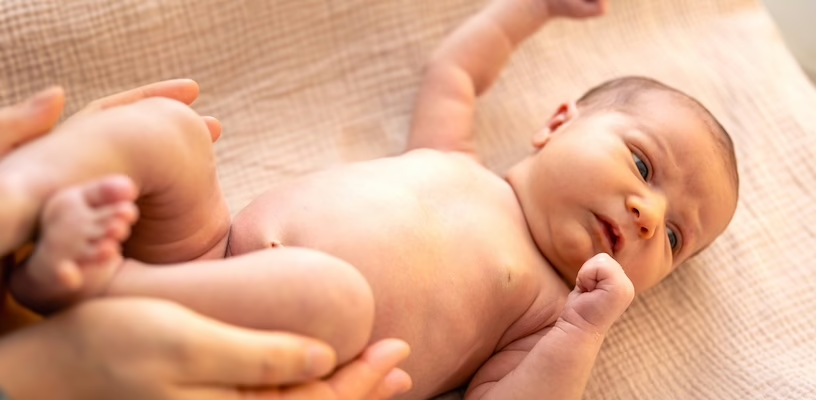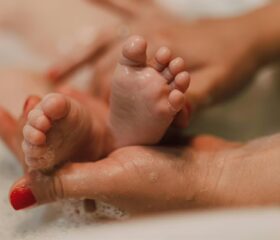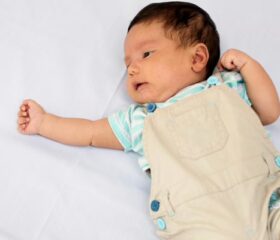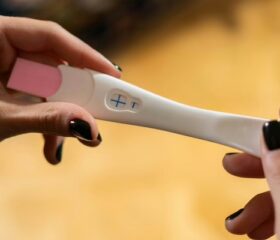The Newborn Startle or Moro Reflex: Causes, Tests, and Timeline
That sudden flailing of arms with an arched back and startled cry is probably your baby’s Moro reflex, also known as the startle reflex.

The Moro reflex can look a bit dramatic, but it’s a normal and important part of your newborn’s development. What exactly is it, why does it happen, and when should you expect it to disappear? Let’s dive into the details of this fascinating (if mildly alarming) newborn reflex.
What is the Moro reflex?
The Moro reflex (which, again, is also called a startle reflex or embrace reflex) is an involuntary protective response that newborns exhibit when startled by a sudden stimulus or trigger. 1
This reaction is often sparked by: 2 3
- A loud noise
- Bright lights
- A quick or sudden movement
- The sensation of falling or a change in position 4
- Your baby’s own cry (yes, really)
The Moro reflex is one of many involuntary motor responses, known as primitive reflexes, that your baby was born with to help her survive. They’ll last until her brain matures and she learns how to control them more actively (a process which is sometimes called reflex integration). 5
What does the Moro reflex look like?
When something triggers your baby’s reflex, she may flail her arms and legs outwards with a cry, arch her neck and back, and fan out her fingers. Then, she’ll quickly bring her arms back in towards her body as if she’s going to hug herself before relaxing again. 3
This reflex should be symmetrical (equal on both sides of her body). 6
Again, her reaction might look alarming, but it’s a completely normal and healthy reflex in newborns.
Why do babies have the Moro reflex?
A sudden change or lack of support can activate your baby’s vestibular system (her sense of balance and orientation). This sets off a protective reaction in response to a potential fall.
Most experts believe that the reflex is a byproduct of evolution. One popular theory is that it used to help babies cling to their mothers to prevent falling. 7
Moro reflex vs. startle reflex: what’s the difference?
As mentioned, many people use the terms “Moro reflex” and “startle reflex” interchangeably. However, they’re actually not exactly the same.
The startle reflex is an umbrella term that encompasses different types of responses. The Moro reflex, which we described above, is more specific.
As the Moro reflex fades or integrates, it will mature into the startle reflex that older children and adults have when they get scared.
When does the Moro reflex develop and how long does it last?
The Moro reflex develops while your baby’s in the womb. You may be able to see it on an ultrasound by the time you’re 16 weeks pregnant, and it becomes more coordinated around week 28 of pregnancy. 8 5
It’s normally present at birth and should fade when your baby’s between 2 months old and 6 months old. 3 9
If the reflex persists beyond this point, it’s important to discuss it with your pediatrician. A retained Moro reflex can impact your baby’s well-being or indicate possible issues with her development.
What happens when your baby’s Moro reflex doesn’t go away?
A retained Moro reflex may cause (or correlate with) issues that could affect your baby’s focus, mood, and overall quality of life. These include: 4
- Sleeping problems
- Impulsive behaviors
- Unusual sensitivity to light, sound, or motion
- Motor and neurodevelopmental delay
If your child has retained primitive reflexes, your doctor can evaluate her and recommend therapies and exercises that can help integrate her reflexes. 10 11 12 13
Can an adult still have the Moro reflex?
It’s abnormal for an adult (or even an older infant or child) to have the Moro reflex. If the reflex persists beyond 4–6 months (or disappears before the expected time), it may signal cerebral palsy. In general, when reflexes that should disappear in infancy reappear in adults, it can suggest a possible brain issue.
How pediatricians assess the Moro reflex
Chances are, your doctor checked for this reflex right after birth, along with other reflexes and signs of health. 1 They’ll do it again during your baby’s check-ups. This assessment helps them evaluate your baby’s neurological development.
The process of checking your baby’s Moro reflex may look unsettling if it catches you off-guard, but it’s nothing to be afraid of. First, your doctor will lay your baby on her back on a soft mat. Then, they’ll carefully lift your baby’s arms up (slightly) and let go to simulate the sensation of falling and activate the reflex. 14
It looks a little dramatic, but it’s just a quick test to see how your baby reacts. They won’t let her get hurt.
What pediatricians look for when assessing the Moro reflex
Again, the Moro reflex triggers a sudden outstretching and shaking of the arms (and sometimes legs), as well as a shocked look on your baby’s face if she’s awake.
When your pediatrician checks for the Moro reflex, they’ll look for several key indicators that your baby’s neurological development is progressing as expected: 1 5
- Presence: They’ll check to see if your baby has a reflex at all. An absence of this reflex could indicate a problem with your baby’s central nervous system. This absence usually results from a birth injury, problems with your baby’s brain, infection, muscular weakness, or cerebral palsy. 14
- Symmetry: Does your baby’s reflex occur equally on both sides of the body? Asymmetrical responses (e.g., one arm extending while the other doesn’t) might suggest a birth injury, nerve damage, or a fractured clavicle. 14
- Strength: Is the reflex strong and prominent? Premature babies can have a weak or sluggish reflex because their muscles aren’t as strong yet. It could also point to an issue with the central nervous system.
Don’t panic if your baby has a poor, asymmetrical, or absent Moro reflex. Your doctor will be able to run a diagnostic test to see if there’s actually an issue and coach you on how to care for your baby if there is.
When to see your doctor about your baby’s Moro reflex
See your doctor if your baby’s Moro reflex is still evident after 6 months or if it disappears before your baby hits 2 months.
A Moro reflex can look similar to infantile spasms, which is a type of epilepsy that requires prompt medical attention, although unlike the Moro reflex, it doesn’t happen in response to sudden sound or movement.
Consult your pediatrician immediately if you notice any unusual movements in your baby, such as if she: 15 16 17
- Rolls her eyes back while bobbing her head
- Raises her arms above her head or stretches them out to the side
- Stiffens her legs or pulls them up toward her tummy
- Tenses or jerks her belly, head, neck, arms, and legs
Seizures and infantile spasms like this are characterized by rhythmic jerking (almost like your baby is moving to the beat of music). They can’t be triggered or stopped by touching or moving your baby.
These seizures only last for a second or two, but can come back-to-back in clusters, and are most common right after babies wake up in the morning or after a nap. 17
Recording a video of the movements can be helpful for your pediatrician to assess.
How to calm your baby down from a Moro reflex
While the Moro reflex is a normal part of newborn development, it may sometimes disrupt your baby’s sleep and comfort. Here are a few tips to minimize startling:
- Swaddling: Wrapping your baby snugly in a swaddle (or even just holding her close) can help calm crying. Swaddling also restricts her movements and prevents her from startling herself awake, which is a common problem in newborns. 18 19
- Gentle handling: When putting your baby down to sleep, lower her gently and support her head to avoid triggering the sensation of falling.
- Tummy time: Putting your baby on her side or tummy can turn off this reflex and help her calm down, partly because of the pressure on their tummy. You can also hold her in a breastfeeding position or against your shoulder to achieve this. Always put her to sleep on her back to prevent Sudden Infant Death Syndrome (SIDS). 20
- White noise: Playing white noise can mask sudden loud noises that might startle your baby.
- Dim rooms: Since light may be an issue, try taking your baby to a dimly lit room. 4
Other newborn reflexes to keep an eye on
As mentioned, the Moro reflex isn’t the only one your baby’s born with. Here’s a brief overview of the other reflexes: 6
| Reflex | Definition | Timeline |
|---|---|---|
| Stepping | When you hold your baby upright with her feet touching a surface, she automatically places one foot in front of the other, mimicking walking. | Birth to 2 months |
| Rooting | Your baby turns her head toward you when you touch her cheek or mouth to try to find a nipple. | Birth to 4 months |
| Palmar grasp | Stroking your baby's palm causes her to grip your finger tightly. | Birth to 5–6 months |
| Tonic neck reflex (Fencing) | When your baby's head turns to one side, her arm on that side straightens out while the other arm bends, like a fencing pose. | Birth to 5–7 months |
| Plantar grasp | Stroking the sole of your baby’s foot makes her toes curl. | Birth to 9–12 months |
Final thoughts
The Moro reflex is a startling but important part of your baby’s early development. While it may be strange to witness, you can navigate one of your baby’s developmental milestones now that you understand its purpose and what to expect.
If you have any concerns about your baby’s Moro reflex, don’t hesitate to reach out to your pediatrician for guidance.
Article Sources
- MedlinePlus. "Moro reflex" Retrieved November 12, 2025.
- University of Washington Medical Center. "Caring for Your Baby" Retrieved November 12, 2025.
- The Children's Hospital of Philadelphia. "Newborn-Reflexes" Retrieved November 12, 2025.
- Verywell Health. "Moro Reflex: Why Newborns Startle Easily" Retrieved November 12, 2025.
- StatPearls. "Primitive Reflexes" Retrieved November 12, 2025.
- American Academy of Pediatrics. "Newborn Reflexes" Retrieved November 12, 2025.
- Infant Behavior and Development. "The Moro reaction: More than a reflex, a ritualized behavior of nonverbal communication" Retrieved November 12, 2025.
- University of Utah. "The Basics: Newborn Reflexes" Retrieved November 12, 2025.
- Stanford Medicine Children’s Health. "Newborn Reflexes" Retrieved November 12, 2025.
- The Autism Community in Action. "Primitive Reflex Integration" Retrieved November 12, 2025.
- Creighton University. "Effectiveness of a Movement Program for Elementary Students" Retrieved November 12, 2025.
- University of Mississippi Medical Center. "Creating an Interdisciplinary Screening Tool for Retained Primitive Reflexes in a Pediatric Setting" Retrieved November 12, 2025.
- University of the Pacific. "Yoga for Neurodiverse Individuals: A best practice plan for therapists, teachers, and parents of children and young adults with autism spectrum disorder" Retrieved November 12, 2025.
- StatPearls. "Moro Reflex" Retrieved November 12, 2025.
- The Children's Hospital of Philadelphia. "Infantile Spasms Syndrome (West Syndrome)" Retrieved November 12, 2025.
- Cleveland Clinic. "Infantile Spasms" Retrieved November 12, 2025.
- University of Pittsburgh Medical Center. "Infantile Spasms Symptoms and Diagnosis" Retrieved November 12, 2025.
- The Children's Hospital of Philadelphia. "Newborn-Sleep Patterns" Retrieved November 12, 2025.
- Harvard Health Publishing. "Should you swaddle your baby?" Retrieved November 12, 2025.
- Iowa Health Care. "How to calm your fussy baby" Retrieved November 12, 2025.







